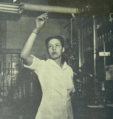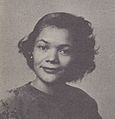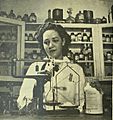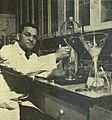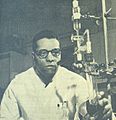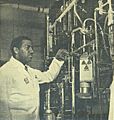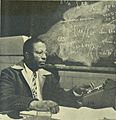African-American scientists and technicians on the Manhattan Project facts for kids
African-American scientists and technicians on the Manhattan Project were a small but important group among the many people who worked on the Manhattan Project during World War II. This secret project aimed to build the first atomic bombs.
At the time, their work was kept very secret. Most people didn't know the real purpose of what they were doing. But over time, historians have learned more about the contributions of people like chemist William Jacob Knox Jr., chemist Lloyd Quarterman, physicist Carolyn Parker, physicist Robert Johnson Omohundro, and physicist and mathematician Jesse Ernest Wilkins Jr..
These scientists helped in many ways. Wilkins worked on understanding nuclear physics. Knox and Quarterman helped get and process Uranium-235, a special type of uranium used in the bombs. Parker worked with polonium, which was used to start the bomb's reaction. Omohundro developed tools to find radioactive materials and measure radiation.
The small number of African Americans in these science and tech jobs shows the structural discrimination they faced back then, and still do today. Their experiences were different depending on where they worked. For example, no African Americans lived at Los Alamos, New Mexico, a main project site, before 1947. In places like Oak Ridge, Tennessee, segregation (keeping people of different races separate) and unfair rules were very strict. White couples could live together, but Black couples could not. Conditions were a bit better at the Hanford Site in Hanford, Washington, and even more so at Columbia University in New York City and the Metallurgical Laboratory at the University of Chicago in Chicago. Still, African-American scientists faced unfair treatment and racism.
Today, researchers are studying the important role African Americans played in the Manhattan Project. They also look at how technology and ethnic identity connected, and how African Americans felt about being involved.
Contents
What Was the Manhattan Project?
The Manhattan Project was a huge research effort led by the United States during World War II. Its goal was to create the first atomic weapons. Major General Leslie Groves of the U.S. Army Corps of Engineers was in charge.
Scientists and engineers worked at over thirty secret locations in the U.S., the United Kingdom, and Canada.
- At Columbia University, scientists studied the basic ideas of atomic particles and did experiments.
- Oak Ridge, Tennessee was where they figured out how to process uranium and make plutonium.
- The Metallurgical Laboratory at the University of Chicago built the first human-made nuclear reactor.
- The Hanford Site produced plutonium.
- And at Los Alamos, they designed the atomic bombs.
About 130,000 Americans worked on the Manhattan Project between 1941 and 1946. Their jobs ranged from construction workers to top scientists. The project was extremely secret. In 1945, a magazine called Life guessed that only a few dozen people in the whole country knew the project's full meaning. Maybe only a thousand others even knew it involved atoms.
When World War II ended, so did the Manhattan Project. The Atomic Energy Act was signed in 1946, creating the Atomic Energy Commission (AEC). Los Alamos became the Los Alamos National Laboratory, and the Chicago Metallurgical Laboratory became the Argonne National Laboratory. Many African-American scientists continued their work at Argonne, while others found jobs in teaching or industry.
Scientists and Technicians
Only a few African-American men and women were among the hundreds of scientists and technicians on the Manhattan Project. After the project became public, magazines like Ebony praised these African-American scientists as role models and "progressive heroes."
Education and Background
Where scientists and technicians grew up greatly affected their education. In 1910, most African Americans lived in the Southern United States. Between 1916 and 1940, many moved to cities in the North and West. This was called the Great Migration. They looked for better jobs and living conditions. A Second Great Migration started in 1940, with more African Americans moving North for skilled jobs, often in defense.
Educational chances were limited, especially in the South. In 1933, only 18% of Black students in the South went to high school, compared to 54% of white students. Segregated Black schools had fewer resources and offered less science training. Northern schools offered more, but racism was still a problem.
Here are some examples of scientists and their education:
- Moddie Daniel Taylor was born in Alabama. He studied at Lincoln University, a historically Black college. He earned his Ph.D. from the University of Chicago in 1943 and then worked at the Metallurgical Laboratory for the Manhattan Project.
- Jasper Brown Jeffries was from North Carolina. He went to West Virginia State College, a historically Black college. He later earned his master's degree in physical sciences from the University of Chicago in 1940.
- Lloyd Quarterman was born in Philadelphia. He got his bachelor's degree from St. Augustine’s College, a Black college in North Carolina, in 1943. He then joined the Manhattan Project as a junior chemist.
- Harold Delaney also from Philadelphia, earned his degrees from Howard University, a historically Black university, before joining the project.
- William Jacob Knox Jr. and his brother Lawrence H. Knox were born in Massachusetts. Both earned Ph.D.s before WWII. William was denied housing with white students at Harvard University, but still earned his bachelor's degree there. He got his Ph.D. from Massachusetts Institute of Technology in 1935.
- His brother Lawrence got degrees from Bates College and Stanford University before earning his Ph.D. from Harvard University in 1940.
- J. Ernest Wilkins Jr. was a child genius from Chicago. He started the University of Chicago at age 13 and got his Ph.D. in math at 19 in 1942. He taught at Tuskegee Institute before joining the Manhattan Project in 1944.
Working and Living Conditions
In 1941, President Franklin D. Roosevelt signed Executive Order 8802. This happened because of pressure from African-American leaders like A. Philip Randolph. The order said:
"The United States wants all citizens to fully participate in the national defense program, no matter their race, religion, color, or national origin. We believe that our democratic way of life can only be defended with the help of all groups in our country."
The order also said there should be no discrimination in hiring for defense jobs or government work. This meant federal projects like the Manhattan Project offered new chances for African Americans. However, they still faced racism. Depending on the location, workers dealt with segregation and unfairness in pay and housing.
Los Alamos, New Mexico
No African Americans worked as scientists or technicians at Los Alamos before 1947. The first African American hired there was Clayborne Carson Sr., who became a security inspector for the United States Atomic Energy Commission.
Oak Ridge, Tennessee
Oak Ridge, Tennessee was built specifically for the Manhattan Project. It was made a military area in 1943. Southern lawmakers insisted that the project be segregated as a condition for funding. Most African Americans there worked as lower-level laborers.
White and African-American workers lived in separate areas, sometimes divided by a barbed-wire fence. Lower-paid Black laborers lived in crowded, gender-separated "hutments." The women's area was even called the "Pen." Higher-paid white workers could live in houses in their own neighborhoods, and white couples could live together. A neighborhood for higher-paid Black employees was planned but never built. Black couples were forced to live separately in the "hutments." Restrooms, water fountains, dining areas, and fun activities were all separated by race.
Living conditions for African Americans in Oak Ridge got worse as buildings wore down. In 1945, a writer named Enoch P. Waters wrote in the Chicago Tribune:
"If America has advanced science here, it has also hurt democracy by how it forced Black people to live. This is ironic because the whole project was created to protect democracy."
Hanford, Washington
The Hanford Site was also created for World War II. The DuPont Company managed the site and hired African-American workers, but they purposely limited the number to about 10–20% of the workforce. This was just enough to meet the rules.
Housing was segregated and limited. Only one nearby city, Pasco, Washington, would accept African Americans. DuPont provided only two buildings for Black workers. Others lived in poor conditions in tents, shacks, or trailers. The NAACP guessed that 80% of businesses in Hanford refused to serve African-American customers.
Columbia University, New York City
Columbia University in New York City hired African-American scientists and technicians. Some, like James Forde, had lower-level lab jobs. But William Jacob Knox Jr. was a research associate. He developed ways to use a gas called uranium hexafluoride to separate uranium isotopes. This work was vital for the project. Willard Libby made William Knox the supervisor of the Corrosion Section, which was otherwise all white. This was the highest position held by any African American in the Manhattan Project.
Chicago Metallurgical Laboratory, Chicago, Illinois
The Chicago Metallurgical Laboratory at the University of Chicago was the most likely place for African-American scientists to hold important positions. The University of Chicago had accepted African-American students since 1890. Arthur Compton, the lab's director, supported hiring a diverse group of workers.
Many African Americans at the Met Lab were University of Chicago graduates. These included Jesse Ernest Wilkins, Moddie Daniel Taylor, and Jasper Brown Jeffries. Edwin Roberts Russell was a Ph.D. student when he joined. After the war, several men earned more degrees, like George Warren Reed Jr., Harold Delaney, Ralph Gardner-Chavis, and Benjamin Franklin Scott.
Mathematician and engineer Jesse Ernest Wilkins and Ralph Gardner-Chavis first worked with Enrico Fermi on studying plutonium. European scientists like Fermi were often more open to working with African Americans. In 1944, Wilkins joined Eugene Wigner's team. They worked on how neutrons are absorbed. Wilkins' discoveries include the Wilkins Effect and the Wigner-Wilkins approach, which help calculate how nuclear energy is distributed in reactors.
When Wigner's team was going to move to Oak Ridge, it was thought that Wilkins couldn't go with them and keep his high-level scientific job. Edward Teller suggested Wilkins to Harold Urey, the director of war research. Wilkins stayed at the Met Lab.
"Knowing that highly qualified people are rare these days, I thought it might be helpful to suggest a capable person for this job. Mr. Wilkins in Wigner's group at the Metallurgical Laboratory has been doing excellent work, according to Wigner." Edward Teller to Harold Urey.
Jeffries and Wilkins later signed the Szilárd petition. This petition asked President Truman to warn Japan or show them the atomic bomb before using it. After the war, Wilkins worked as a mathematician and later managed a research division that explored peaceful uses of nuclear energy.
George Warren Reed Jr. worked at the Met Lab purifying uranium. He tried to get the same benefits as white researchers under the G.I. Bill, but he was not successful. After the war, Reed continued to work with the University of Chicago and its successor, the Argonne National Laboratory. He later studied meteorites and lunar samples from the Apollo missions.
Major Contributions
The work on the Manhattan Project was kept very secret. But we now know that several African-American scientists made important scientific contributions. They helped understand nuclear physics and process Uranium-235, which was used in the Little Boy atomic bomb. An African-American physicist worked with polonium, which was used to start the Fat Man bomb. Others developed tools to detect elements and radiation.
William Jacob Knox Jr., a physical chemist, joined Columbia University in 1943. He became the head of the Corrosion section of the nuclear research team. This was a unique position for an African American in the project. Knox's team developed ways to separate uranium isotopes using a gas called uranium hexafluoride. This complex process was crucial for making the atomic bombs. After the war, Knox joined Eastman Kodak Company and became known for his work with photographic materials.
Chemist Lloyd Albert Quarterman worked at Chicago's Met Lab from 1943 to 1949. He worked with fluorine, a very dangerous element. He designed and built a system to purify large amounts of hydrogen fluoride, which was used to separate Uranium-235 from uranium. He later helped design the atomic reactor for the first nuclear-powered submarine.
Carolyn Parker, a physicist, worked from 1943 to 1947 on the Dayton Project in Ohio. This project did top-secret research on using polonium and beryllium for the "Urchin" initiator, which was used in the Fat Man bomb. Parker is believed to have worked with polonium on this project. Sadly, she died of leukemia at age 48.
Jesse Ernest Wilkins Jr. worked on the Manhattan Project at the University of Chicago starting in 1944. As a physicist and mathematician, he worked directly under Eugene Wigner, the head of the Theoretical Physics group. Their theoretical work was the basis for the Hanford fission reactor. Wilkins helped solve problems with reactor design and developed what are now called "the Wilkins effect, and the Wigner-Wilkins and Wilkins spectra for thermal neutrons." The Wigner-Wilkins approach helped calculate how nuclear energy is distributed in reactors. Wilkins went on to have an amazing career as a mathematician, physicist, and engineer.
Physicist Robert Johnson Omohundro used mass spectrometry to find elements in material samples. During WWII, he developed tools to detect and measure radioactive materials and radiation. After the war, he continued to develop and patent radiation detection instruments. His technology was used by the International Atomic Energy Agency, in airports to detect nuclear materials, and in portable neutron detectors.
Scientists and technicians by location
| Name | Date of birth | Gender | Work location | Position | Sources |
|---|---|---|---|---|---|
| Carter, George Sherman | 1911 | male | Columbia University | scientist | |
| Knox, Lawrence H. | 1906 | male | Columbia University | scientist | |
| Knox Jr., William Jacob | 1904 | male | Columbia University | scientist | |
| Massie, Samuel P. | 1919 | male | Ames Laboratory, Iowa State University, | scientist | |
| Omohundro, Robert Johnson | 1921 | male | Arizona-based | technician | |
| Parker, Carolyn Beatrice | 1917 | female | Dayton Project | scientist | |
| Boykin, Pearline (or Perline) | c. 1911 | female | Met Lab | technician | |
| Delaney, Harold | 1919 | male | Met Lab | scientist | |
| Evans Jr., Harold B. | 1907 | male | Met Lab | scientist | |
| Gardner-Chavis, Ralph | 1922 | male | Met Lab | scientist | |
| Jeffries, Jasper Brown | 1912 | male | Met Lab | scientist | |
| Lawrence, Blanche J. | 1921 | female | Met Lab | technician | |
| Quarterman, Lloyd | 1918 | male | Met Lab | scientist | |
| Reed, George Warren | 1920 | male | Met Lab | scientist | |
| Russell, Edwin Roberts | 1913 | male | Met Lab | scientist | |
| Scott, Benjamin Franklin | male | Met Lab | scientist | ||
| Summers, Mildred M. | 1913 | female | Met Lab, Hanford and Argonne Labs | ||
| Taylor, Moddie Daniel | 1912 | male | Met Lab | scientist | |
| Wilkins Jr., Jesse Ernest | 1923 | male | Met Lab | scientist | |
| Forde, James | 1927 | male | Columbia University | technician | |
| Hall, Cynthia | female | Argonne Lab | |||
| Tyree, Ella B. | female | Argonne Lab | |||
| Wallace, Herschel | male | Argonne Lab | |||
| Sellars, Phillip A. | male | Argonne Lab | |||
| Pairs, Robert B. | male | Argonne Lab | |||
| Tyler, Sylvanus | male | Argonne Lab | |||
| Trice Jr., Virgil Garnett | 1926 | male | Argonne Lab |
Legacy
The legacy of the Manhattan Project is complicated. The Little Boy atomic bomb, made with Uranium-235, was dropped on Hiroshima. The Fat Man bomb, made with plutonium and polonium, was dropped on Nagasaki. Most people working on the project didn't know their work would lead to such destruction. But they knew they were helping the war effort.
At least two African-American scientists, Jasper Brown Jeffries and Jesse Ernest Wilkins Jr., knew about the plan to bomb Japan by July 1945. Both signed the Szilárd petition to try and stop it. Others didn't know what they were contributing to. James Forde, a 17-year-old lab assistant, remembered his shock: 'I saw the headline where we had dropped the bomb. I said, “Oh my God. That is what I was working on.”'
African Americans, like other Americans, had different feelings about the atomic bomb. Some saw it as a terrible act, others as a necessary way to end the war, and some as a patriotic achievement. Some African Americans felt that their involvement in the Manhattan Project showed that they deserved civil rights. They hoped that science could help overcome racism.
At the same time, leaders like W. E. B. Du Bois, Langston Hughes, and Walter Francis White criticized the bomb in Black newspapers. Roy Wilkins wrote an article asking, "Who is barbarian and who is civilized?" He and others wondered if the Allies were fighting a "racial war" by using the bomb against the Japanese but not against Europeans. Langston Hughes wrote that "Japs is colored," highlighting the racial aspect.
Later, African-American leaders like Malcolm X, Bayard Rustin, Coretta Scott King, Martin Luther King Jr., and members of the Black Panther Party protested nuclear weapons and testing. Martin Luther King Jr. connected racial injustice, poverty, and war. Those who saw the atomic bomb in terms of anti-colonialism and a world community were often more critical than those who focused on national opportunities for civil rights.
As a Ph.D. student, Samuel P. Massie had to choose between being drafted for war or working on the Manhattan Project. He later said, “All of us had to make a decision how we would serve the war efforts. I dropped out of school and went into the chemical warfare service.” After the war, Massie became a respected organic chemist, researching treatments for diseases like malaria. His granddaughter, Victoria Massie, has written about how hard it is to understand these different parts of her grandfather's life now that he is gone.
See Also
- African Americans in science and technology
- African Americans in the military
- Women in the Manhattan Project


